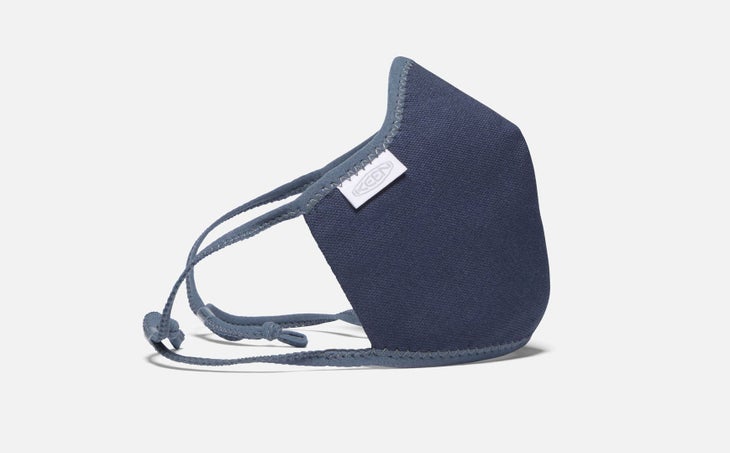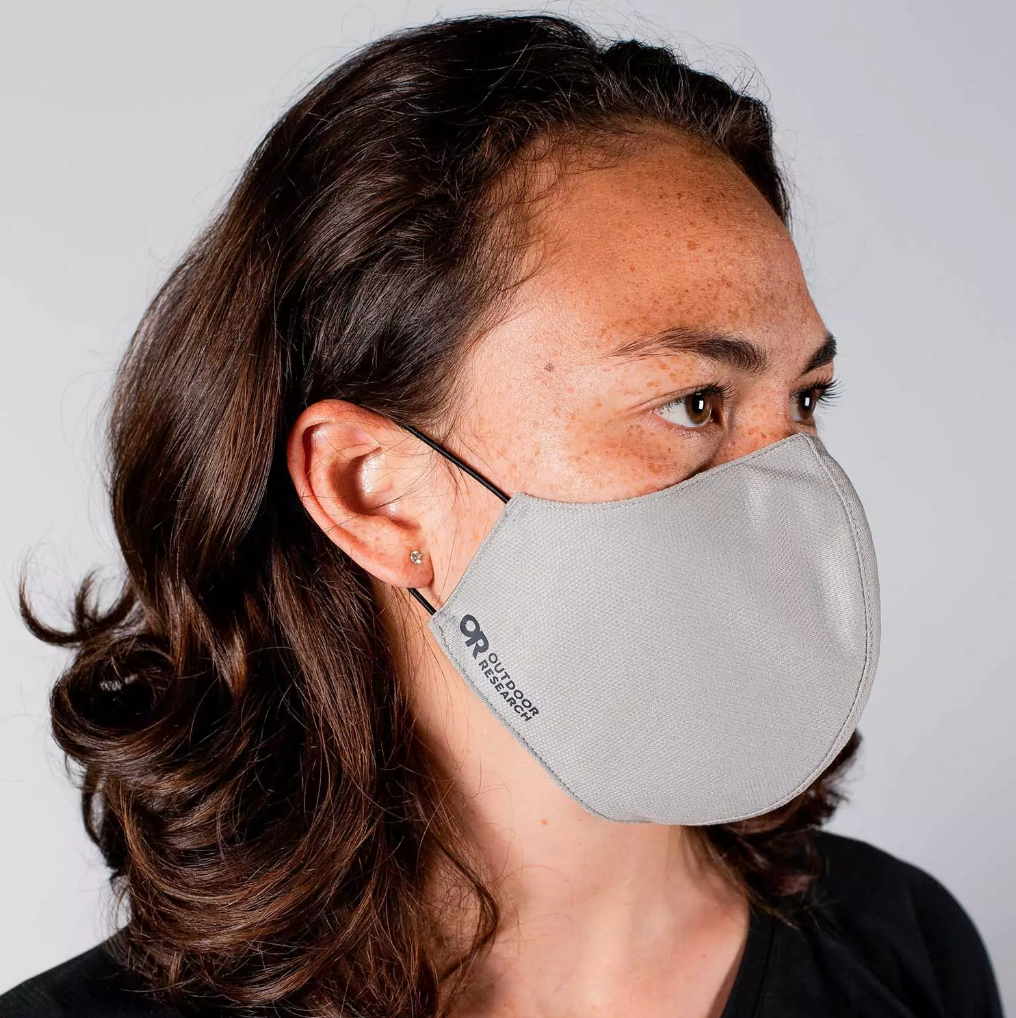One way to trace the progression of the pandemic is to look at the consumer demand for masks. In the beginning, there were devastating shortages and disturbing stories of profiteers and stockpilers. Then came a period of tenuous equilibrium, when the use of homemade face shields, bandanas, and other DIY solutions proliferated. Now, everyone is coming to terms with the fact that we will probably be wearing face coverings for a long time, which raises an important question: How will we run, hike, bike, ski, and聽socialize safely鈥攊n other words, incorporate masks more permanently into our lives鈥攊n a way that’s not maddeningly uncomfortable and divisive?
Several companies in the outdoor industry, including big players like Outdoor Research and Keen, think they’ve come up with an answer: produce, market, and sell masks like gear.
A New Category: PPE as Activewear
“We鈥檝e put together a long-term strategy,” said Liz Wilson, vice president of product at Outdoor Research, who is overseeing an effort to ramp up the company’s production of reusable, non-medical masks for consumers and retailers鈥攁n effort that comes directly on the heels of a similar initiative now producing 200,000 masks a day for state and federal agencies. “Rather than approach this opportunistically by asking what we had lying around that we could make into masks,聽we set about making a really great new product.聽What happens when people go back to work, back to gyms? They’re going to want something that fits really well, that they can exercise in, that they barely realize is there.”
To meet that demand, Outdoor Research is launching an entirely new line of product called Protective Essentials that will kick off with an Essential Face Mask Kit, shipping June 1, and expand by the fall to include gloves, balaclavas, and face shields designed for high-output aerobic activities like climbing, skiing, and running. Items in the line will be fully packaged to preserve sanitation, Wilson says, so that retailers can stock the products without compromising consumer trust. And the packaging itself will be thoughtfully designed: According to Wilson, the plastic sleeves will act as reusable sterilizing devices that harnesses UV light to kill viruses and bacteria.
“This isn鈥檛 a one-hit wonder for us. People are going to be concerned about safety for at least a year,” she said. “In this thing [the pandemic], you鈥檙e either the ostrich sticking your head in the sand, or you go into panic mode, or you adapt. We are adapting very rapidly. We鈥檙e going to maintain our core lines, but we also see these new products as a really important thing for people to continue to get outside.”
Another major brand undertaking a similar effort is Keen, which has made the decision to expand beyond footwear to meet extraordinary demand for reusable PPE. Washable cloth masks will debut on the company’s website in mid-June.
鈥淎s the world adjusts to life with COVID-19, we know that wearing masks in public will be an important part in keeping this virus in check until a vaccine is developed and widely applied,” Erik Burbank, Keen’s chief brand officer, said of the effort. “Until that time, we are supporting the CDC recommendations regarding the use of cloth face coverings by making comfortable masks that people feel good about wearing every day in public.”
The masks will be produced in Thailand, in a factory the company converted for the express purpose of starting the new line, and will be made of cotton canvas certified by the Better Cotton Initiative (BCI), available in seven colors.

Another Strategy: Stopgap Products
Beyond these larger efforts, a handful of smaller companies have also found success marketing masks directly to consumers. In the outdoor space, the most prominent of these is Hyperlite Mountain Gear, based in Maine. In late March, the gear brand was forced to lay off half its staff and consider new ways to drive revenue. One day after the layoffs, CEO Mike St. Pierre started working on a mask design and sourcing components.
“We had no idea what the demand was going to be,” he said. “Things moved quickly. It was eight days from concept to selling. We launched the masks on our website on a Friday and the response was instant. By Monday we had 70,000 orders. We were able to bring everyone back to work.”
Despite that success, however, St. Pierre doesn’t see the masks as a long-term product.
“We weren’t looking at this as a long-term play. We just wanted to get our people back to work. When we launched this, it was right when the CDC says masks in public will be mandatory. I think there will be some demand for these in the long term, but the market is getting super saturated.”
He’s not wrong. Though the number of outdoor companies making reusable masks for consumers remains relatively small, dozens of businesses in other spaces鈥攆rom The Gap to Disney to the NBA鈥攁re hopping on the mask bandwagon and splintering demand.
“We just wanted to get people through until we could start building our products again,” St. Pierre said. “I’m hopeful that our core products are going to come back really strong. That’s where we ultimately want to be.”
Features, Specs, Price
Safety is obviously the top concern for mask production, but Keen, Outdoor Research, and others are also getting granular with the tech specs of these new products鈥攕omething their customers have come to expect when buying anything performance-related.
Outdoor Research’s masks are treated with聽HeiQ NPJ03 antiviral textile technology聽and come with three removable filters for added protection. “High breathability” is discussed in the product’s promo material. Keen’s version is “consciously created with pure BCI-certified cotton canvas…[with] adjustable ear loops for a custom fit,” as one of the company’s reps described them to 国产吃瓜黑料 Business Journal. The Hyperlite version is made of “interlock micro polyester with a skin-friendly, durable, water-repellent coating.”
This kind of attention to detail and alignment with brand quality has allowed companies to charge anything from $20 for a pack of five (Hyperlite) to $25 for a single mask (Outdoor Research), though representatives from all three businesses say none of the mask lines aims to bring in big margins.
“We took all the components and priced them together and considered what鈥檚 fair,” Wilson said. “We鈥檙e not looking to make a huge profit here, we鈥檙e just looking to make a great product at a fair price.”
The Way Forward
As time goes on, more outdoor brands will likely join these initial major players by creating new products to fit a shifting consumer landscape. And if demand remains where it is鈥攑rovided outdoor enthusiasts don’t start buying masks from Disney or professional basketball teams鈥攊nvestors should have absolutely no problem with that.
“Our partners and investors have really been cheering us on. This wasn鈥檛 something that our parent company directed. It came from the inside of this brand and started growing,” said Wilson, who believes the story is perfectly in line with Outdoor Research’s identity as a company. “Accessories built this brand in the first place. We started with a neck gaiter. We like to say we own the hands, head, and ankles. This really fits for us.”


